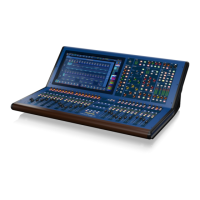158 HD96-24-CC-TP User Manual
HD670
The Fairchild 670 tube compressor not only achieves record bids in high-end vintage gear auctions, it also delivers some of the nest colorations in compressor
history. A six-step switch determines the timing, and the two large Input and Threshold controls adjust the levels. Our model is true to the original signal path, and
conveniently provides models for dual, stereo-linked or M/S operation. Inspired by Fairchild 670.
Input gain determines how much of the input signal passes through the eect. On toggles the compressor in or out of the signal path. Threshold determines how loud
the signal has to be before compression is applied. Time switches the compression’s release time. Bias changes the simulated tube bias algorithm and adjusts the knee
of the compression from soft to hard via 4 settings. Out gain aects the gain of the output signal. Balance set to its default setting controls the amount of additive
signal deection know as ‘thud’ which happens due to an attack. At this setting it is minimized. Setting this control counter-clockwise from this position results in a
thud of one polarity on transients and going clockwise produces a thud of opposite polarity.
The terms lateral (side-to-side) and vertical (up-and-down) refer to the mechanical modulations in a vinyl record groove that are transduced into electrical audio
signal’s by the phonograph stylus and cartridge.
The HD 670 can perform dynamics processing on the lateral (LAT) and vertical (VERT) components of stereo signal’s independently. In other words, the monophonic
(middle) and/or stereo (side) components of a stereo source signal can be compressed or limited separately from the other component.
can also be used for creative eects outside of the phonograph environment.
Lat/Vert processing is accomplished by rst routing the stereo source signal through a sum/dierence (mid/side) matrix which separates the stereo source into lateral
(middle, or centre without stereo) and vertical (side, or stereo without mono) signal components. The lateral/vertical components are then compressed or limited
independently. Finally, the mid/side components are recombined into a normal stereo signal via a second sum/ dierence matrix.
In lateral/vertical mode the HD 670 operates as two monophonic compressors with independent control of the middle and side components of the two input signal’s.
The input signal’s are processed by the sum/dierence (mid/side) matrix before and after the compressors, but there is no interaction between the two compressors.

